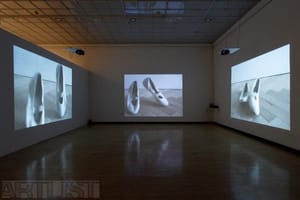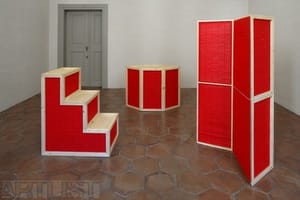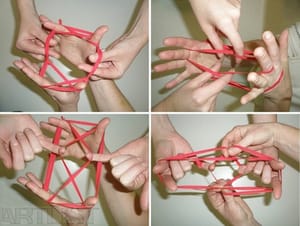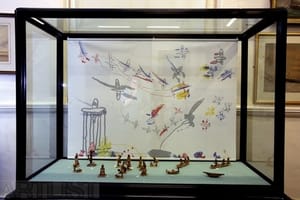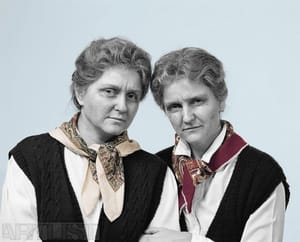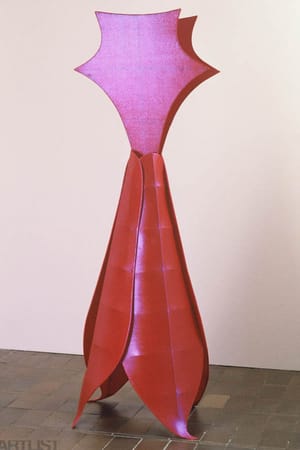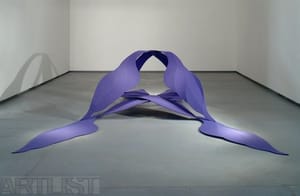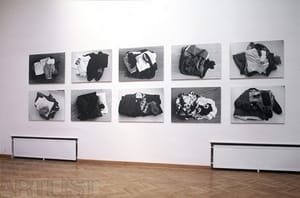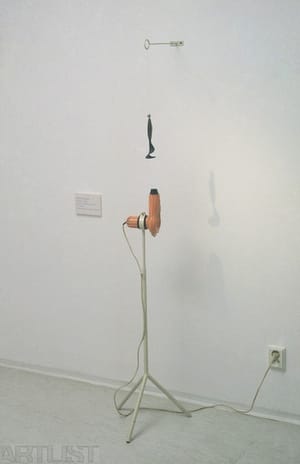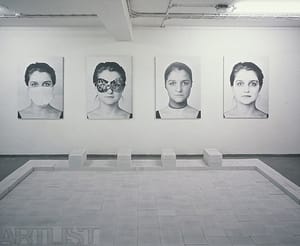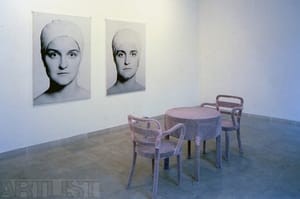- First Name
- Milena
- Surname
- Dopitová
- Born
- 1963
- Birth place
- Šternberk
- Place of work
- Prague
- Website
- www.milenadopitova.cz
- i-datum
- ↳ Find in the VVP AVU database
- Keywords
- CSU Library
- ↳ Find in the catalogue
About artist
Since the start of the 1990s, Milena Dopitová has been creating installations, objects, videos, and photography. Very often, especially during the 90s, an installation comprises several different media. Dopitová is a conceptual artist with a social focus. Amongst other things she actively reflects on the position of women in contemporary society and culture. In 1989 she became the first female artist to join the Pondělí group.
Dopitová examines themes relating to social identity. She is concerned with the general phenomena which each of us encounters but which are often subject to taboo. She has a personal take on themes such as growing up, aging, death, insecurity, cruelty or violence, while all the time allowing us to observe how they are incorporated into wider social relations. Although her message relates to us all, her art has very personal, even intimate roots. It often involves very authentic experiences which Dopitová had in her own family.
In one of her first works entitled Twins: Me and My Sister (1991) she examines questions of human identity. Photographs of the heads of the artist and her sister in bathing caps are set within an installation of tables and two wicker-covered chairs. There follows a cycle of projects in which Dopitová, as she herself puts it, is concerned with hygiene. The work features various appliances which we use to improve our body but which are not essential to life. Examples are her red Solarium (a construction covered in wool from 1992), Four Helmets (hairdressing caps again covered in fabric from 1994), and the tiled object Follow Me (1994), which is inspired by training in a fitness centre.
Dopitová is fascinated by the fact that several of these appliances are instruments of torture to which we make our bodies available. The theme of death is presented in the work entitled I Do Not Expect To Change (1993). The impulse behind this work was the powerful experience of the artist’s mother’s clinical death. An object covered in red wool represents a tunnel which is passed through by those who have experienced clinical death and have seen a light at the end. The tunnel is combined with elements of a gynaecology chair, which hints at the birth of a new life, a new light.
The photographic cycle Wishing Wall (1995) is related to death. Dopitová took photographs of the legs of dead bodies with nametags. After 1999, video becomes more and more important in the artist’s work. She returns to the theme of death in her video Shave Make Up (1999), in which the artist examines the last “modifications” made to dead bodies prior to burial. She was fascinated by the different wishes people have regarding this last procedure. The theme of the inexorable onset of old age is examined in Dopitová’s multimedia installation Sixtysomething (2003)A video shows us the artist and her sister being transformed by a makeup artist into two women in their sixties who experience an ordinary day. The work is a reaction to the contemporary cult of youth in our society. Whoever is old and cannot acquire a youthful appearance is marginalised. It is interesting that in the USA this work encountered hostility on the part of older women. Perhaps it provoked a traumatic reaction by threatening to reveal the real face carefully concealed beneath the mask of makeup and cosmetic operations.
Over the last two years Dopitová’s work has been free of the deeper themes of birth, aging and death. The artist says that she has arrived at a period in life in which, as she says, “I want to create a positive energy which is missing in today’s society. People need a completely different type of injection. I am not interested in frustration: you see this on TV from morning to night. For me it is important to have a positive relationship with life”.
The video project M.M.D. (2009) reveals a more playful side to Dopitová’s work. The central protagonists are gym shoes, one of the symbols of the world prior to the Velvet Revolution. At present, the last of Dopitová’s exhibitions, entitled I’ll Stay a Little Longer, was held in Brno and brings together the artist’s work of the last two years. These latest works seem to reflect the artist’s new found balance and security in life. As she herself says, these works also represent a personal testimony and interpretation of her own life, feelings and emotions. However, the emotiveness with which Dopitová reflects the world is only minimally visible. Instead, the language of these works is restrained, unpretentious, and at first sight very simple. The artist presents timeless and generally valid topics, such as interpersonal relationships, memory, transience, beauty, and responsibility towards basic human values.
- Author of the annotation
- Ivona Raimanová
CV
Studies:
1986-1994 AVU, Praha, atelier of Milan Knížák
Grants and stipends:
2002 International and Curatorial Programme, New York
1997 MAK Schindler Residency, Los Angeles
1997 The Sculpture Place, Utica New York
1996 The Fabric Workshop, Philadelphia
1995 The Mattress Factory, Pittsburgh
1994 Canberra School of Art, Canberra
1994 The Institute of Contemporary Art, Boston
1993 Progetto 93, Civitella d’Agliano
1992 Nottingham Polytechnic, Nottingham
1991 Galerie 68elf, Cologne
1990 Internationale Sommerakademie, Salzburg
Awards:
2011 Michal Ranny Award, Brno
2003 Tranzit, Prague
1997 The Pollock-Krasner Foundation, INC., New York
1997 The Central European Culture Initiative Prize, Wien
- Member of art groups included in ARTLIST.
Exhibitions
- Solo exhibitions
-
2012
Mine, Come on, I've got it, Mine, I'm on it!, POLANSKY GALLERY, Prague
Spleen, Jadro Gallery, Brno
2011
Where My First End?, City Gallery Blansko
I'll Stay a Little Longer, Moravian Gallery, Brno (awarded of Michal Ranny Award)
2007
Come, I’ll Show You the Way Through Paradise, American Center, Prague
2006
Does wind also have rays?, City Gallery, Karlovy Vary
2005
Sixtysomething, JIRI SVESTKA GALLERY, Prague
2004
Everything What I Want You May Wish Too, Exhibition Hall Sokolska, Ostrava
Washing Day, Display Gallery, Prague
2003
Sixtysomething, Ronald Feldman Fine Arts, New York
Green Plateaus, House of Lords of Kunstat, Brno
2002
I´m Gonna Make You Wonder if You Are My Friend, Czech Centre, New York
2001
Come,I´ll Show You the Way Through Paradise, Museum Ostdeutsche Galerie, Regensburg; together with Jasansky/Polak (catalogue)
2000
Come,I´ll Show You the Way Through Paradise, JIRI SVESTKA GALLERY, Prague
foyer of the Czech Parliament´s House of Commons, refused works for EXPO 2000 Hannover
1999
Installations 1992 – 1999, The Brno House of Arts; Ludwig Museum, Budapest, Kunsthalle Krems (catalogue)
JIRI SVESTKA GALLERY, Prague
I’m Gonna Make You Wonder if You Are My Friend, 761 Gallery, Ostrava
1996
Gallery MXM, Prague
1995
Prague City Gallery (catalogue)
Don’t Be Afraid to Take That Big Step, Gallery 86, Trier
1994
You Must Remember This, Ronald Feldman Fine Arts, New York (with David Cerny)
Leo Model Exhibition Hall, Jerusalem (with Pavel Humhal) (catalogue)
Milena Dopitova in Context, The Institute of Contemporary Art, Boston
Milena Dopitova in Context, Carpenter Center, Boston
1993
Gallery MXM, Prague
1992
Gallery MXM, Prague (with Jiri Kovanda)
1991
Objects and Installations, City Gallery, Sternberk
- Group exhibitions not included in ARTLIST.
-
2013
Biennale der Kunstler, Haus der Kunst München
Inner Circle, City Gallery, Prague
Open Brno, House of Arts, Brno
Expiration Date, Galerie Emila Filly, Usti nad Labem
Magnus Art 2013, Karlin Hall, Prague
2012
Islands of Resistance, National Gallery, Prague
Beginning of the Century, Masne kramy, Pilsen
Second Season AMoyA , Prague
Beginning of the Century in Piblic Space, festival Pilsen
Puzzle, Meet Factory, Prague
2011
Mutating Medium, Gallery Rudolfinum, Prague
The Art of Urban Intervention, Emil Filla Gallery, Usti nad Labem
The Salon of Zlin, House of Art, Zlin
Prague Biennale 5, Prague
2010
Inter-view, Nitranska Galeria, Nitra, SK
Paris Photo, Carrousel du Louvre, Paris
...And Don't Forget the Flowers, Moravian Gallery, Brno
Esprit Vakuum, Mikulov Castle
A Part of No-Part, Chelsea Art Museum NY
Formate der transformation, MUSA - Museum auf Abruf Vienna
Gender Check" Zacheta, National Gallery of Art in Warsaw
2009
Photography and Concept, Prague House Brussels
Gender Check, Rollenbilder in der Kunst Osteuropas
Museum moderner Kunst Stiftung Ludwig Wien
Family peace, Nostic Palace, Prague
Czech Photography of the 20th Century, Art and Exhibition Hall of the Federal
Republic of Germany, Bonn
Behind the Velvet Curtain: Contemporary Art from the Czech Republic,
Katzen Ars Center, Washington, D.C.
Crossing frontier, City Prague Gallery n Municipal Library, Prague 2008
IN/visible festival of visual art, Flora, Olomouc
Close Encounters:Central European Video Art, Fine Arts Center Galleries,
University of Rhode Island, USA
Self-portrait in Czech art of the 20th Century, AJG – Ales South Bohemian Gallery,
Hluboka nad VltavouRealizace v architektuře a veřejným prostorách
Crossing frontiers, Municipal Library - City Gallery Prague, Municipal Library
Photography and Concept, Prague House Brussels
Gender Check, Rollenbilder in der Kunst Osteuropas
Museum moderner Kunst Stiftung Ludwig Wien
Family peace, Nostic Palace, Prague
Czech Photography of the 20th Century, Art and Exhibition Hall of the Federal Republic of Germany, Bonn
Behind the Velvet Curtain: Contemporary Art from the Czech Republic, Katzen Ars Center, Washington, D.C.
Crossing frontier, City Prague Gallery – Municipal Library, Prague
2008
IN/visible festival of visual art, Flora, Olomouc
Close Encounters:Central European Video Art, Fine Arts Center Galleries,University of Rhode Island, USA
Self-portrait in Czech art of the 20th Century, AJG – Ales South Bohemian Gallery, Hluboka nad Vltavou
2007
Locws 3, Swansea Museum, Swansea, Great Britain
Global Feminism, Brooklyn Museum, New York
Crossing Frontiers. Looking for an Artistic Identity in Eastern Europe, Ludwig Museum, Budapest
Punctum, Futura – Centre for contemporary art, Prague
Gross Domestic Product, Municipal Library, City Gallery Prague
2006
Grenzgänger – Künstlerische Identitätssuche im Östlichen Europa, KOG Regensburg
AMOR VINCIT OMNIA, Palais am Festungsgraben, Berlin
I invited some friends to come and watch, Galerija Nova, Zagreb
Autopoesis, Slovak National Gallery, Bratislava
Giardino – Places for Small Stories, PAN, Palazzo delle Arti di Napoli, Naples
Praagse Tuin – beelden uit Praag, Gouverneurstein van Assen, Holland
Frisbee - Contemporary Czech videoart and new media, The Brno House of Arts
Zyklus 1.0 Tschechien – Ferne Nähen, Stift Lilienfeld, Austria
2005
Artstars, making of, Galerie du Moulin d’Asselborn
Czech Photography of the 20th Century, City Gallery Prague
Prague Biennale 2: Expanded Painting, International Contemporary Art, Karlin Hall, Prague
Heart Nightwatch, Summerhouse Hvezda, Prague
Cultural Domestication - Instinctual Desire, Center for the Visual Arts, University of Toledo, Ohio
2004
E.U. positive - Kunst aus dem neuen Europa, Akademie der Künste, Berlin
Flipside, Artists Space, New York
Troubled Times, Gruppo 78 I.C.A., Gallery LipanjePuntin, Trieste
2003
Glamour - British Council, Prague
Phantom of Desire - Visions of Masochism in Art, Neue Galerie Graz
Generations – Galerie K&S, Berlin
Aus Liebe - Die Generation der 90er in Prag, Galerie der Stadt Remscheidt
2002
Imagination - Romanticism, Galway Arts Centre, Galway, Ireland
Monday - Plain Air, City Gallery Ostrava
Corps et traces, Musée de Beaux-Art de Nancy (catalogue)
Extradiction, Aqua museum, Lisbon
Politik-um/New Engagement, Prague Castle
Imagination – Romanticism, The Brno House of Arts
2001
Extended Transformation, Art Gallery Zagreb
A Sense of Wellbeing, Palace of the Imperial Thermal Baths, Karlovy Vary
Imagination – Romanticism, Botho-Graef-Kunstpreis der Stadt Jena,
Germany (catalogue)
Object - Metamorphoses in Time, Czech Museum of Modern Art, Prague
Milano Europa 2000, Triennale di Milano (catalogue)
Dead, The Roundhouse, London (catalogue)
Extended Transformation, City Gallery Ljubljana
Up in Smoke, Castle Museum and Art Gallery Nottingham
2000
Bohemian Birds – Positions of Czech Contemporary Art, Kunst Haus, Dresden (catalogue)
ArtWORKS, The Whitechapel Art Gallery, London
Girls Show 2000, Art Expo Gallery, Bucharest
Emila Filly Gallery, Usti nad Labem
Human Touch, West Bohemian Gallery, Cheb
Confrontation, Czech Centre, London
1999
Girls Show, MXM Gallery, Prague
Transformation II, Venice Biennial, Italy
Aspect - Positions – 50 Years of Art in Central Europe 1949-99,
Ludwig Museum Budapest, Museum of 20th Century, Wien
L´Autre motié de l´Europe, Galerie nationale du Jeu de Paume, Paris
1998
Interactus 5, Accademia D´ungheria, Rome
Sensibilities (Contemporary Art from Central Europe), European Academy of Art, London
1997
Born ‘68, Czech Centre, Berlin
Art in the Public Space, National Gallery, Prague
1996
Urban Legend, Staatliche Kunsthalle, Baden-Baden (catalogue)
Preobrazaj, Bosnia and Hercegovina Art Gallery, Sarajevo
Interior versus Exterior, Factory Cosmos, Bratislava
1995
A New Europe - Supranational Art, Venice Biennial
Artists of Central and Eastern Europe, Mattress Factory, Pittsburgh
After the Velvet Revolution, Museum of Contemporary Art, Helsinki
Beyond the Borders, Kwangju Biennial
The Image of Europe, Nicosia
1994
After the Spring, Museums of Contemporary Art, Sydney, Canberra, Melbourne
Contemporary Art from the Czech Republic, South London Gallery
22nd Biennial, Sao Paulo (catalogue)
Auszeit, Galerie der Künstler, Munich
Biennial of Young Artists, Stone Bell House, City Gallery Prague
1993
Aperto, Venice Biennial
Art by Women, Old Town Hall, City Gallery Prague (with Mio Shirai, Pipilotti Rist, Jennifer Bolande)
Double Exit, Ludwig Forum, Aachen
Situation Prague, Dialogue of Two Generations, Kampnagel Internationale Kulturfabrik, Hamburg
That, what is left, Stenc’s House, Prague
1992
Sirup, Pasinger Fabrik, Munich
D’une génération á l’autre, Musée d´Art Moderne de la Ville de Paris
Slovaks and Czechs, Maeght Gallery, Paris
Between Aesop and Mowgli, Vaclav Spala Gallery, Prague
Frontiera 1/92, Bolzano
Ninth Biennale - The Boundary Rider, Sydney
1991
Contribution to Luck, Artist’s Gallery, Munich
New Intimate, ULUV Exhibition Hall, Prague
1990
Grand Concours International De Peinture 1990, Musée 2000, Luxembourg
- Collections
-
The Art Collection of Erste Bank Group, Vienna
City Gallery Prague
Czech Museum of Modern Art, Prague
Modern and Contemporary Art Collection, National Gallery, Prague
Carnegie Museum of Art, Pittsburgh
Kunstforum Ostdeutsche Galerie, Regensburg
Milena Dopitova is represented by the Jiri Svestka Gallery
www.jirisvestka.com
- Other realisations
Video:
Milena Dopitova, Director Branka Bogdanov, Editor Reb Butler, 25 minutes, produced by ICA, Boston, 1994
A Live Man is Playing, work of M. Dopitova, produced by Fabric Workshop, Philadelphia, 1996
Monography
- Articles
Jirousová Věra: Na pláních zelených Mileny Dopitové, A2 kulturní týdeník 2/ 2005
Ferencová Yvona: Jak zavřít tlamy lvům, A2 kulturní týdeník 10/ 2006, s. 8

